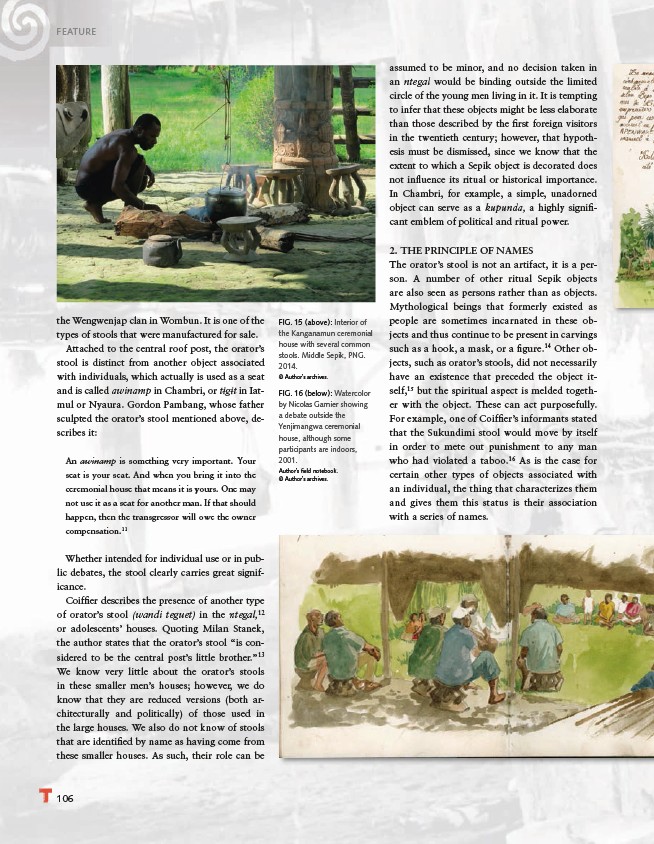
106
assumed to be minor, and no decision taken in
an ntegal would be binding outside the limited
circle of the young men living in it. It is tempting
to infer that these objects might be less elaborate
than those described by the fi rst foreign visitors
in the twentieth century; however, that hypothesis
must be dismissed, since we know that the
extent to which a Sepik object is decorated does
not infl uence its ritual or historical importance.
In Chambri, for example, a simple, unadorned
object can serve as a kupunda, a highly signifi -
cant emblem of political and ritual power.
2. THE PRINCIPLE OF NAMES
The orator’s stool is not an artifact, it is a person.
A number of other ritual Sepik objects
are also seen as persons rather than as objects.
Mythological beings that formerly existed as
people are sometimes incarnated in these objects
and thus continue to be present in carvings
such as a hook, a mask, or a fi gure.14 Other objects,
such as orator’s stools, did not necessarily
have an existence that preceded the object itself,
15 but the spiritual aspect is melded together
with the object. These can act purposefully.
For example, one of Coiffi er’s informants stated
that the Sukundimi stool would move by itself
in order to mete out punishment to any man
who had violated a taboo.16 As is the case for
certain other types of objects associated with
an individual, the thing that characterizes them
and gives them this status is their association
with a series of names.
FIG. 15 (above): Interior of
the Kanganamun ceremonial
house with several common
stools. Middle Sepik, PNG.
2014.
© Author’s archives.
FIG. 16 (below): Watercolor
by Nicolas Garnier showing
a debate outside the
Yenjimangwa ceremonial
house, although some
participants are indoors,
2001.
Author’s fi eld notebook.
© Author’s archives.
FEATURE
the Wengwenjap clan in Wombun. It is one of the
types of stools that were manufactured for sale.
Attached to the central roof post, the orator’s
stool is distinct from another object associated
with individuals, which actually is used as a seat
and is called awinamp in Chambri, or tɨgɨt in Iatmul
or Nyaura. Gordon Pambang, whose father
sculpted the orator’s stool mentioned above, describes
it:
An awinamp is something very important. Your
seat is your seat. And when you bring it into the
ceremonial house that means it is yours. One may
not use it as a seat for another man. If that should
happen, then the transgressor will owe the owner
compensation.11
Whether intended for individual use or in public
debates, the stool clearly carries great significance.
Coiffi er describes the presence of another type
of orator’s stool (wandi teguet) in the ntegal,12
or adolescents’ houses. Quoting Milan Stanek,
the author states that the orator’s stool “is considered
to be the central post’s little brother.”13
We know very little about the orator’s stools
in these smaller men’s houses; however, we do
know that they are reduced versions (both architecturally
and politically) of those used in
the large houses. We also do not know of stools
that are identifi ed by name as having come from
these smaller houses. As such, their role can be